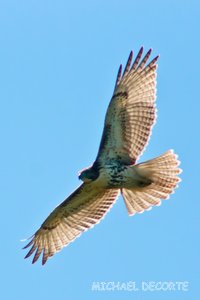 atop Mt. PhiloOn September 18, sixteen RCAS members and friends gathered to travel to Mt. Philo State Park in Charlotte to watch for migrating Broad-winged Hawks. The annual pilgrimage is a hit-or-miss affair, the hawks being very dependent on weather conditions.
atop Mt. PhiloOn September 18, sixteen RCAS members and friends gathered to travel to Mt. Philo State Park in Charlotte to watch for migrating Broad-winged Hawks. The annual pilgrimage is a hit-or-miss affair, the hawks being very dependent on weather conditions.
Broad-winged Hawks, a common raptor in Vermont, need rising thermals to lift them into the air. The thermals are formed when warming air along ridgelines rises.  Broad-winged HawkAs the hawks rise with the thermals, they “peel off” in search of the next rising bubble of warm air and thus make their way south. By doing so they minimize the use of their own energy reserves.
Broad-winged HawkAs the hawks rise with the thermals, they “peel off” in search of the next rising bubble of warm air and thus make their way south. By doing so they minimize the use of their own energy reserves.
After striking out last year, we were fortunate enough to arrive just has several Broad-winged Hawk groups, known as kettles, flew over the rocky outcrop atop Mt. Philo and then high over the sparkling water of Lake Champlain, finally disappearing into the sky over the Adirondacks.
 Red-tailed HawkIn addition to the Broad-winged Hawks, we had the opportunity to study the contrasting shapes of different groups of raptors as they flew by – buteos (Broad-winged and Red-tailed hawks), accipiters (Sharp-shinned and Cooper’s hawks), and falcons (American Kestrels). Knowing the different shapes is a key part of identifying migrating raptors as other field marks are most often not distinguishable at a great distance. For a view of a Broad-winged Hawk has it sailed by below us, click here.
Red-tailed HawkIn addition to the Broad-winged Hawks, we had the opportunity to study the contrasting shapes of different groups of raptors as they flew by – buteos (Broad-winged and Red-tailed hawks), accipiters (Sharp-shinned and Cooper’s hawks), and falcons (American Kestrels). Knowing the different shapes is a key part of identifying migrating raptors as other field marks are most often not distinguishable at a great distance. For a view of a Broad-winged Hawk has it sailed by below us, click here.
 view from Mt. PhiloAs noon drew near the wind shifted to the south and the action drew to a close. The day’s totals included three Bald Eagles, 15 Sharp-shinned Hawks, three Cooper’s Hawks, and nine American Kestrels. In addition, two Red-tailed Hawks, probably not yet in migration, nine Turkey Vultures, and one Great Blue Heron flew by. A flock of seven Wild Turkeys was seen in the fields below.
view from Mt. PhiloAs noon drew near the wind shifted to the south and the action drew to a close. The day’s totals included three Bald Eagles, 15 Sharp-shinned Hawks, three Cooper’s Hawks, and nine American Kestrels. In addition, two Red-tailed Hawks, probably not yet in migration, nine Turkey Vultures, and one Great Blue Heron flew by. A flock of seven Wild Turkeys was seen in the fields below.
And the Broad-winged Hawks? We counted a total of 165. While nowhere near peak migration days of 1,000 at Mt. Philo, everyone was satisfied with the results, the camaraderie of fellow birders, and the beautiful view.
You can read more about Broad-winged Hawks at the Cornell Lab of Ornithology All About Birds website, by clicking here.